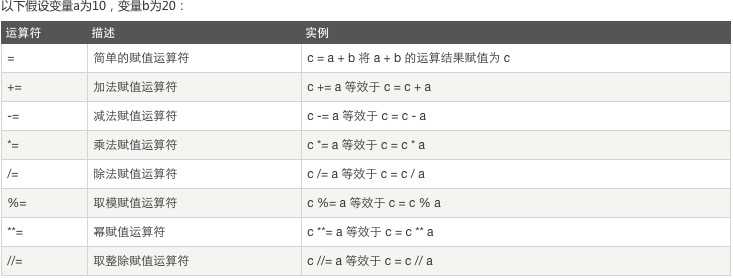标签:
python使用对象模型来存储数据,每一个数据类型都有一个内置的类,每新建一个数据,实际就是在初始化生成一个对象,即所有数据都是对象
对象三个特性
| 标准类型 | 其他类型 |
| 数字 | 类型type |
| 字符串 | Null |
| 列表 | 文件 |
| 元组 | 集合 |
| 字典 | 函数/方法 |
| 类 | |
| 模块 |
定义:a=1
特性:
1.只能存放一个值
2.一经定义,不可更改
3.直接访问
分类:整型,长整型,布尔,浮点,复数
Python的整型相当于C中的long型,Python中的整数可以用十进制,八进制,十六进制表示。
>>> 10
10 --------->默认十进制
>>> oct(10)
‘012‘ --------->八进制表示整数时,数值前面要加上一个前缀“0”
>>> hex(10)
‘0xa‘ --------->十六进制表示整数时,数字前面要加上前缀0X或0x
字符串转int型:
>>> a = "123"
>>> a
‘123‘
>>> b = int(a)
>>> b
123
浮点型转int型:
>>> a = 1.75
>>> b = int(a)
>>> b
1
True和False
1和0
浮点数即小数,如3.14,1.23,-0.77。
但是对于很大或很小的浮点数,就必须用科学计数法表示,把10用e替代,1.23*109就是1.23e9,或者12.3e8,0.000012
可以写成1.2e-5,等等。整数和浮点数在计算机内部存储的方式是不同的,整数运算永远是精确的而浮点数运算则可能会有
四舍五入的误差。

定义:它是一个有序的字符的集合,用于存储和表示基本的文本信息,‘’或“”或‘’‘’‘’中间包含的内容称之为字符串
特性:
1.只能存放一个值
2.不可变
3.按照从左到右的顺序定义字符集合,下标从0开始顺序访问,有序
补充:
1.字符串的单引号和双引号都无法取消特殊字符的含义,如果想让引号内所有字符均取消特殊意义,在引号前面加r,如name=r‘l\thf‘
2.unicode字符串与r连用必需在r前面,如name=ur‘l\thf‘
capitalize() #字符串首字母大写
>>> "hello".casefold()
‘hello‘
enter() #原来字符居中,不够补全
>>> ‘hello‘.center(20,)
‘ hello ‘
>>> ‘hello‘.center(20,‘*‘)
‘*******hello********‘
count() #从一个范围内的统计某str出现次数
>>> "hello".count(‘l‘)
2
>>> "hello".count(‘l‘,0,6)
2
>>> "hello".count(‘l‘,0,2)
0
>>> "hello".count(‘l‘,0,3)
1
endswith() #判断字符串是否以某字符结尾
>>> "hello".endswith("o")
True
>>> "hello".endswith("lo")
True
>>> "hello".endswith("hello")
True
>>> "hello".endswith("k")
False
expandtabs() #将字符串中包含的tab转换成自定义数量的空格
>>> "he\tllo".expandtabs()
‘he llo‘
>>> "he\tllo".expandtabs(0)
‘hello‘
>>> "he\tllo".expandtabs(4)
‘he llo‘
find() #返回字符串中指定字符的下标,如果有重复,则只返回第一次找到的
>>> "hello".find("l")
2
>>> "hello".find("l",0,6)
2
>>> "hello".find("l",0,3)
2
>>> "hello".find("k") #如果字符不在字符串中,返回"-1"
-1
format() #格式化输出
>>> print (‘{0},{1}‘ .format("hel","lo"))
hel,lo
>>> print (‘{0}{1}‘ .format("hel","lo"))
hello
>>> print (‘{}{}‘ .format("hel","lo"))
hello
>>> a,b = "hel","lo"
>>> print (‘{0}{1}‘ .format(a,b))
hello
>>> print (‘{}{}‘ .format(a,b))
hello
index() #返回字符的下标,如果存在多个,则只返回第一个
>>> "hello".index("l",0,4)
2
>>> "hello".index("l",0,3)
2
>>> "hello".index("l")
2
>>> "hello".index("l",0,2) #如果字符不在字符串中,则会报异常
Traceback (most recent call last):
File "<stdin>", line 1, in <module>
ValueError: substring not found
isalnum() #字符串只由字母和数字组成返回true,否则返回false
>>> "hello".isalnum()
True
>>> "hello123".isalnum()
True
>>> "123hello".isalnum()
True
>>> "hello ".isalnum()
False
>>> "".isalnum()
False
isalpha() #都是字母才返回true
>>> "hello".isalpha()
True
>>> "hello ".isalpha()
False
>>> "hello123".isalpha()
False
>>> "123".isalpha()
False
isdigit()、isdecimal()、isnumerice() #判断字符串是否为数字
num = "1" #unicode
num.isdigit() # True
num.isdecimal() # True
num.isnumeric() # True
num = b"1" # byte
num.isdigit() # True
num.isdecimal() # AttributeError ‘bytes‘ object has no attribute ‘isdecimal‘
num.isnumeric() # AttributeError ‘bytes‘ object has no attribute ‘isnumeric‘
num = "四" # 汉字
num.isdigit() # False
num.isdecimal() # False
num.isnumeric() # True
===================
isdigit()
True: Unicode数字,byte数字(单字节),全角数字(双字节),罗马数字
False: 汉字数字
Error: 无
isdecimal()
True: Unicode数字,,全角数字(双字节)
False: 罗马数字,汉字数字
Error: byte数字(单字节)
isnumeric()
True: Unicode数字,全角数字(双字节),罗马数字,汉字数字
False: 无
Error: byte数字(单字节)
islower() 、isupper()、lower()、upper() #判断大小写及转换
>>> "hello".isupper()
False
>>> "HELLO".isupper()
True
>>> "hello".upper()
‘HELLO‘
>>> "HELLO".islower()
False
>>> "HELLO".lower()
‘hello‘
istitle() #判断是否为标题格式
>>> "H".istitle()
True
>>> "Hello World".istitle()
True
>>> "He1".istitle()
True
>>> "He 12".istitle()
True
>>> "Hello world"
‘Hello world‘
>>> "Hello world".istitle()
False
>>> "hello World".istitle()
False
ljust()、rjust() #设定宽度,左、右对齐不全,类似center()
>>> "hello world".ljust(30,"*")
‘hello world*******************‘
>>> "hello world".ljust(30,"*")
‘hello world*******************‘
>>> "hello world".rjust(30,"*")
‘*******************hello world‘
split() #以某个字符作为条件,分割字符串,返回列表
>>> "hello world".split()
[‘hello‘, ‘world‘]
>>> "hello world".split("l")
[‘he‘, ‘‘, ‘o wor‘, ‘d‘]
定义:[]内以逗号分隔,按照索引,存放各种数据类型,每个位置代表一个元素
特性:
1.可存放多个值
2.可修改指定索引位置对应的值,可变
3.按照从左到右的顺序定义列表元素,下标从0开始顺序访问,有序
append() #添加元素到尾部
>>> a = [1,2,3]
>>> a.append(4)
>>> a
[1, 2, 3, 4]
clear() #清空列表
>>> a
[1, 2, 3, 4]
>>> a.clear()
>>> a
[]
copy() #复制一个列表,开辟一块新的内存地址
>>> a
[0, 1, 2, 3]
>>> b = a
>>> id(a)
7413032 #列表a的内存地址
>>> id(b)
7413032 #列表b的内存地址与a相同
>>> c = a.copy()
>>> id(c)
7412512 #列表c的内存地址与a、b不同
>>> a[3] = 4 #修改列表a
>>> a
[0, 1, 2, 4] #
>>> b
[0, 1, 2, 4] #列表b也跟着变了
>>> c
[0, 1, 2, 3] #列表c没有变
extend() #列表扩展,合并两个列表
>>> a
[1, 2, 3, 1]
>>> b
[1, 2, 3, 1]
>>> a
[1, 2, 3, 1]
>>> a.extend(b)
>>> a
[1, 2, 3, 1, 1, 2, 3, 1]
insert() #往指定位置前插入元素
>>> a
[1, 2, 3, 1, 1, 2, 2, 3, 1]
>>> a.insert(2,"hello")
>>> a
[1, 2, ‘hello‘, 3, 1, 1, 2, 2, 3, 1]
pop() #删除元素并打印该元素
>>> a
[1, 2, ‘hello‘, 3, 1, 1, 2, 2, 3]
>>> a.pop(2)
‘hello‘
>>> a
[1, 2, 3, 1, 1, 2, 2, 3]
remove() #删除元素,参数为元素名称,不是下标
>>> a
[1, 2, 3, 1, 1, 2, 2, 3]
>>> a.remove(1)
>>> a
[2, 3, 1, 1, 2, 2, 3]
>>> a.remove(3)
>>> a
[2, 1, 1, 2, 2, 3]
reverse() #反转列表中元素顺序
>>> a
[0, 1, 2, 3, 4]
>>> a.reverse()
>>> a
[4, 3, 2, 1, 0]
sort() #排序
>>> a
[0, 3, 5, 1, 4, 7]
>>> a.sort()
>>> a
[0, 1, 3, 4, 5, 7]
>>> a #python3中不可以对int和str混合类型的列表排序
[0, 1, 3, 4, 5, 7, ‘hello‘]
>>> a.sort()
Traceback (most recent call last):
File "<stdin>", line 1, in <module>
TypeError: unorderable types: str() < int()








标签:
原文地址:http://www.cnblogs.com/zd1009/p/5968858.html